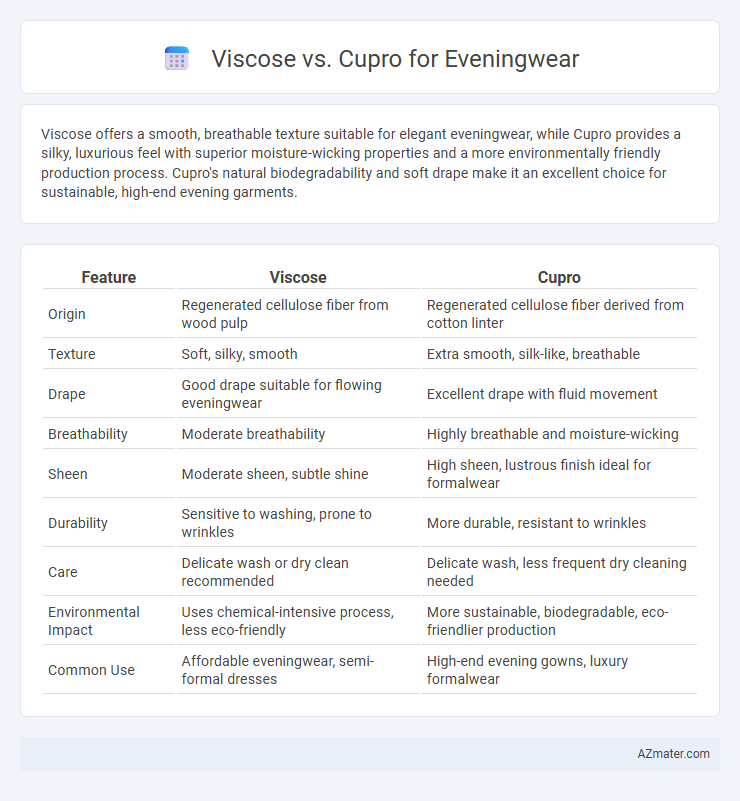Viscose offers a smooth, breathable texture suitable for elegant eveningwear, while Cupro provides a silky, luxurious feel with superior moisture-wicking properties and a more environmentally friendly production process. Cupro's natural biodegradability and soft drape make it an excellent choice for sustainable, high-end evening garments.
Table of Comparison
| Feature | Viscose | Cupro |
|---|---|---|
| Origin | Regenerated cellulose fiber from wood pulp | Regenerated cellulose fiber derived from cotton linter |
| Texture | Soft, silky, smooth | Extra smooth, silk-like, breathable |
| Drape | Good drape suitable for flowing eveningwear | Excellent drape with fluid movement |
| Breathability | Moderate breathability | Highly breathable and moisture-wicking |
| Sheen | Moderate sheen, subtle shine | High sheen, lustrous finish ideal for formalwear |
| Durability | Sensitive to washing, prone to wrinkles | More durable, resistant to wrinkles |
| Care | Delicate wash or dry clean recommended | Delicate wash, less frequent dry cleaning needed |
| Environmental Impact | Uses chemical-intensive process, less eco-friendly | More sustainable, biodegradable, eco-friendlier production |
| Common Use | Affordable eveningwear, semi-formal dresses | High-end evening gowns, luxury formalwear |
Introduction to Viscose and Cupro
Viscose, a semi-synthetic fiber derived from wood pulp, offers a soft, breathable, and lightweight fabric ideal for eveningwear that drapes elegantly and maintains vibrant colors. Cupro, an eco-friendly regenerated cellulose fiber made from cotton linter, provides a silky texture with excellent breathability and a luxurious sheen, enhancing the sophistication of formal attire. Both fabrics prioritize comfort and aesthetic appeal, making them popular choices for stylish, breathable evening garments.
Key Characteristics of Viscose
Viscose offers a soft, smooth texture with excellent breathability, making it ideal for comfortable eveningwear that drapes elegantly. Its high moisture absorbency helps regulate temperature, ensuring wearers stay cool and comfortable during long events. Despite being less durable than Cupro, Viscose provides a luxurious feel and vibrant color retention, enhancing the sophistication of evening gowns.
Essential Features of Cupro
Cupro offers a luxurious, silky texture with excellent breathability and moisture-wicking properties, making it ideal for elegant eveningwear. Its natural origin from cotton linter ensures a soft, smooth finish that drapes beautifully while being hypoallergenic and gentle on sensitive skin. The fabric's superior sheen and durability set it apart from viscose, providing a sophisticated look that resists wrinkling and maintains structure throughout events.
Comparison of Texture and Drape
Viscose offers a smooth, silky texture with a fluid drape that complements eveningwear by enhancing movement and creating an elegant silhouette. Cupro, derived from cotton linter, features a softer, more lustrous finish with a weightier drape that provides a structured yet graceful fall, ideal for sophisticated gowns. Both fabrics excel in breathability and sheen, but Cupro typically delivers a richer texture and a more luxurious draping effect compared to the lighter and more flowy viscose.
Breathability and Comfort in Eveningwear
Viscose offers excellent breathability due to its natural cellulose fibers, making it comfortable for eveningwear by allowing air circulation and moisture absorption. Cupro, a regenerated cotton fiber, provides a luxurious smooth feel with superior drape but is slightly less breathable than viscose, making it ideal for structured evening garments that require elegance and softness. Both fabrics enhance comfort, but viscose is preferred for warmer settings, while cupro excels in cooler environments or more formal occasions.
Color Vibrancy and Dye Affinity
Cupro exhibits superior dye affinity compared to viscose, resulting in richer color vibrancy that maintains its brightness under various lighting conditions, making it ideal for eveningwear. Viscose, while capable of good color uptake, tends to fade faster due to its lower resistance to washing and sunlight exposure. The smooth, lustrous finish of cupro enhances color depth, providing a more luxurious and radiant appearance crucial for elegant evening attire.
Sustainability and Eco-friendliness
Viscose, derived from wood pulp, involves intensive chemical processing with environmental concerns including deforestation and water pollution, while Cupro, made from cotton linter, offers a more sustainable alternative due to its use of cotton waste and biodegradability. Cupro production often employs closed-loop systems that recycle chemicals and minimize waste, enhancing eco-friendliness compared to conventional viscose manufacturing. Choosing Cupro for eveningwear supports sustainable fashion by reducing reliance on virgin materials and lowering the ecological footprint of fabric production.
Fabric Care and Maintenance
Viscose eveningwear requires gentle hand washing or dry cleaning to prevent fabric weakening and color fading, as it is prone to shrinkage and wrinkles. Cupro offers superior durability with easy care instructions, including machine washing on a delicate cycle and low-temperature ironing, making it more wrinkle-resistant and less prone to pilling. Both fabrics benefit from air drying away from direct sunlight to maintain their smooth texture and rich appearance.
Price Point and Accessibility
Viscose offers a budget-friendly option for eveningwear, making it accessible to a wider range of consumers due to its lower price point compared to Cupro. Cupro, derived from cotton linter, is generally more expensive owing to its complex production process and luxurious texture, appealing to those seeking premium fabrics. Availability of Viscose is broader in mass-market retailers, while Cupro is often found in high-end boutiques, influencing accessibility based on shopping preferences.
Best Uses for Eveningwear: Viscose vs Cupro
Viscose offers a soft, breathable texture with excellent drape, making it ideal for fluid evening gowns and dresses that require a silky feel and vibrant color retention. Cupro, derived from regenerated cellulose fibers, provides a luxurious sheen and smooth finish, perfect for structured eveningwear with a slight stretch for comfort and elegance. Both fabrics excel in moisture absorption and comfort but differ in durability and care, with cupro often favored for high-end, tailored garments and viscose preferred for affordable, flowy designs.

Infographic: Viscose vs Cupro for Eveningwear
 azmater.com
azmater.com